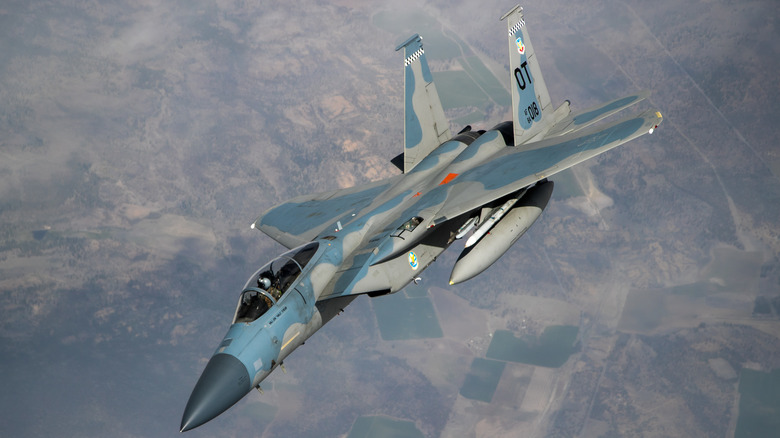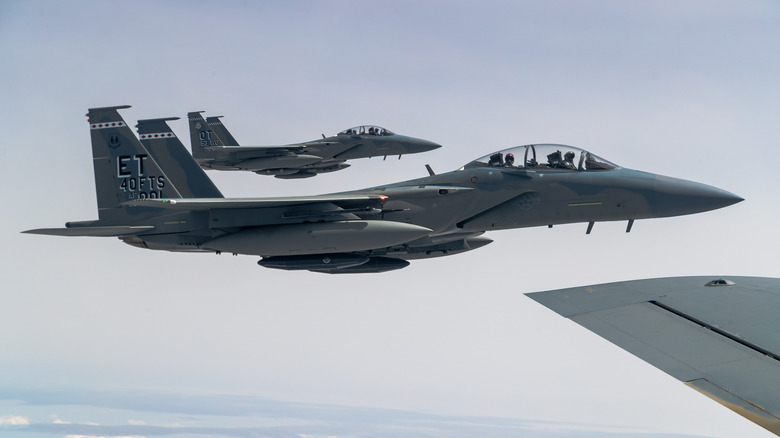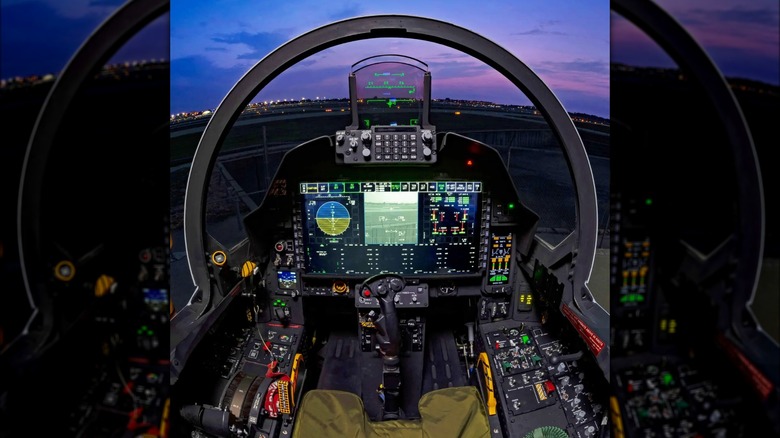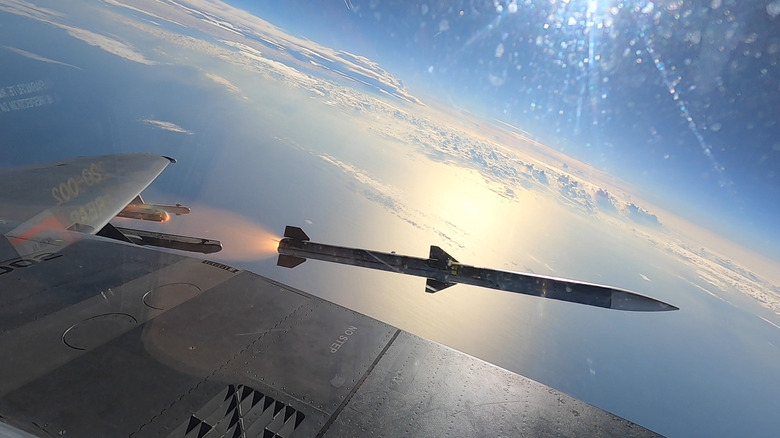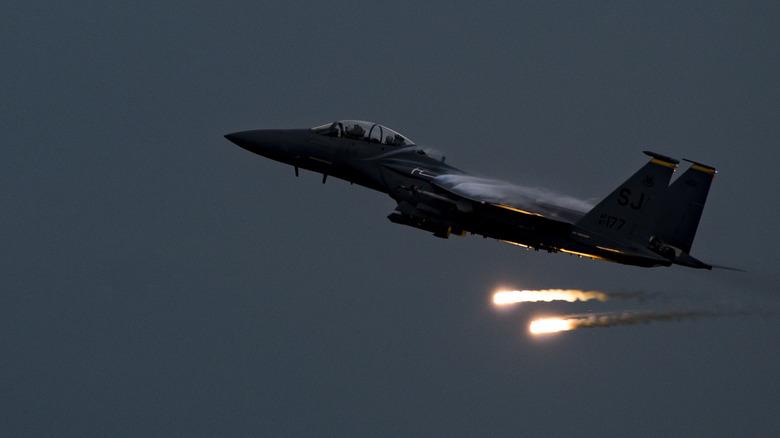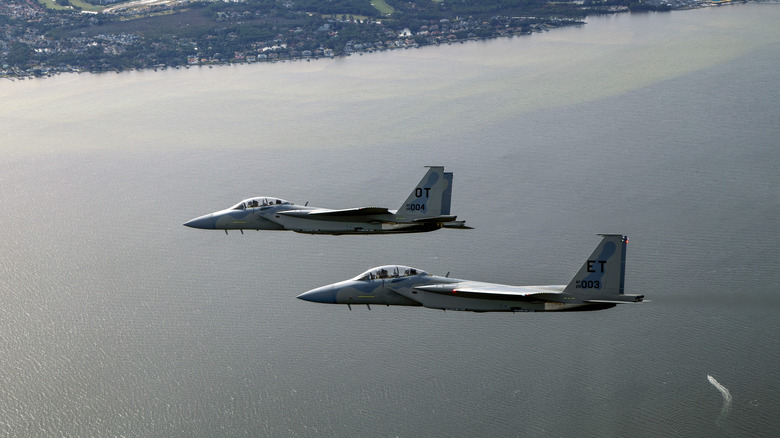All You Need To Know About The F-15EX Eagle II: The U.S Air Force's Missile Truck
The Air Force has been planning to replace most of the aging Cold War-era fighter jets in its service, such as the F-16 Fighting Falcon, with the F-35 for a long time. As a result, the U.S. Air Force Chief of Staff General David Allvin discussed the service's ideal future force structure: a combination of the F-35A Lightning II and F-15EX Eagle II fighters in an interview with Defense One. What may be surprising is its decision to continue using its 50-year-old F-15 Eagle fleet well into the future with an update: the F-15EX Eagle II.
In addition to a strengthened airframe, the Eagle II boasts updated avionics and cockpit design, a more powerful radar, and stronger engines. Most notably, it features two extra wing pylons for increased weapon carriage capacity.
The last feature is the main reason why the Air Force is buying the jet. While the F-35 utilizes four internal weapon stations in its standard stealth configuration, the F-15EX carries double the weapons by default. Sure, the F-35, in its "Beast Mode" configuration, can carry additional pylons to boost usable weapon stations to 11, but the F-35's stealthiness would also be compromised.
As a result, the Air Force intends to leverage the stealthy F-35 to penetrate and suppress enemy air defenses. Once the smoke settles, the F-15EX would sweep in to "clean up" the area of other threats or support ground units by carting in its large, 30,000-pound weapon payload.
It's the Newest Addition to the Strike Eagle Family
The original F-15 Eagle slogan was "not a pound for air to ground", indicating its status as a thoroughbred air superiority fighter. In the 80s, though, as the Air Force sought a replacement for its F-111 Aardvark fighter bomber, it found the F-15 airframe fit the role particularly well with some modifications — the result: the F-15E Strike Eagle. Besides new conformal fuel tanks to extend its range and mounting point for extra hardpoints, the Strike Eagle is very similar to the dual-seat F-15D Eagle but with the airframe reinforced, avionics upgraded, plus equipment for a Weapon Station Officer in the back.
Taking its first flight in 1986, the Strike Eagle, albeit capable, is getting a bit long in the tooth. That's where the F-15EX comes in. With this iteration, the aircraft more or less received a top-to-bottom overhaul, with the biggest upgrade yet being the flight control system.
The hydro-mechanical control is swapped with a fly-by-wire system, which offers the pilot more control of the jet and enhanced flight stability. But more importantly, it addresses a design flaw in the previous F-15E model by automatically dampening in-flight flutter, freeing up the use of two extra outboard underwing pylons (both of which were disabled in previous versions for safety reasons).
The Eagle Goes Digital
The F-15EX got a new powerplant in the General Electric F110-GE-129, which gave the jet an extra 4,500-pounds of thrust compared to the old engines on legacy Eagles. All the extra thrust is put to good use in increasing the F-15EX's weapon capacity.
Eagle II also gets a new class of radar. Instead of the mechanically-scanned AN/APG-70 of the F-15E, the F-15EX has an active electronically-scanned array (AESA) in the form of the Raytheon AN/APG-82(V)1. Electronically-scanned arrays like the APG-82 don't need to be swivel and thus have fewer moving parts and maintenance needs. It's also more powerful, has faster scan rates, and is less susceptible to jamming. Overall, the APG-82 should greatly increase its detection and weapon engagement range even against stealthy targets with low radar cross-section. The radar could be further augmented by the Lockheed Legion Pod, an infrared search-and-track sensor pod that can help the F-15EX passively detect distant targets.
Stepping into the cockpit, the pilots of the Eagle II got a new glass interface. While old F-15Es are equipped with black-and-green monochrome displays and steam gauges, the F-15EXs chuck them out for colored 10x19-inch Large Area Displays (LADs) for both the pilot and the WSO. The new screen lets the pilots manage their workloads better by allowing them to set up their display based on their personal preference and mission set while displaying inputs from the numerous new sensors on the F-15EX at higher resolutions than the 80s-era displays can.
Why It's Called a Missile Truck
Let's talk weapons — it's here that the F-15EX gains the moniker "missile truck" within the Air Force. The F-15EX can carry a total of 12 missiles, either medium-range AIM-120 AMRAAM or short-range AIM-9X Sidewinder (22 missiles can be carried with the newly-proposed AMBER carriage rack).
Missile engagements are made even more effective (and deadlier) with the F-15EX's integration of the Joint Helmet-Mounted Cueing System II (JHMCS II). A targeting reticle is projected onto the pilot's visor, allowing them to simply look at a target to lock onto it. Even if the enemy is not directly in front of the aircraft, pilots can use high-off boresight capabilities of the AMRAAM and Sidewinder missiles to engage targets.
For air interdiction or precision strike missions, the F-15EX can swap out its air-to-air missiles for up to 24 ground-strike munitions of various types (glide bombs, cruise missiles, etc.) In total, the Eagle II can carry around 30,000 pounds worth of munitions. To put that into perspective, one of the most legendary World War II bombers, the B-17 Flying Fortress, can only haul a maximum of 17,600 pounds of bombs!
And then there's the M61A1 Vulcan cannon built into the airframe. With a magazine of 500 20mm rounds, the cannon can be used for both close-in air-to-air combat or close-air support.
Self-Reliance with New Electronic Warfare Suite
The main task that the Air Force envisioned the F-15EX's forebearer, the F-15E, to have is to perform air interdiction without needing to be packaged together with escorts or electronic warfare aircraft, such as the EA-6B Prowler. To that end, the F-15E was equipped with the Tactical Electronic Warfare System (TEWS), which includes radar warning receiver, electronic countermeasures (ECM), chaff/flare dispenser, and other components to help protect the aircraft while it's flying on its own.
For the F-15EX, TEWS is replaced with the AN/ALQ-250 Eagle Passive Active Warning Survivability System (EPAWSS). Like TEWS, the EPAWSS is a one-pod-fits-all that can simultaneously handle jamming, radar warning, threat geolocation, countermeasure dispensing, and more — all in a more modern and lighter package than the TEWS.
Initially, the system was only supposed to go into the F-15EX. However, in 2022, BAE Systems won the contract to upgrade some older F-15Es with the EPAWSS. It'll allow the older Strike Eagles to fly alongside the Eagle II for a while yet as newer aircraft trickle into the Air Force's inventory.
The Exact Number Is Uncertain
Although the F-15EX is a core part of the Air Force's future force structure, the service is debating with Congress over the exact number of aircraft needed. Initially, the Air Force aimed to procure 144 F-15EXs. However, that number has dwindled over the years with a hard cap of 98 aircraft. The F-15EX itself isn't a problem. Rather, the Air Force is leaning toward research and development of new capabilities rather than procuring new airframes in its fiscal plans.
Congress, on the other hand, is pushing for more F-15EXs. The draft of the 2025 National Defense Authorization Act, prepared by the House Armed Services Committee, includes around $271 million to lay the groundwork for an additional 24 F-15EXs in 2026. This would increase the planned fleet size to around 122 airframes.
But the F-15EXs won't be the only Eagles flying for a while. According to the Pentagon's April 2024 force structure report, the Air Force plans to retain around 99 later-production F-15Es equipped with more powerful engines in its inventory. Notably, all these Strike Eagles will be equipped with the EPAWSS to enhance their survivability.
Whatever final number the Air Force and Congress choose, one thing's for certain: the Eagle family is here to stay. The synergy of the F-15EX's missile-trucking ability, together with the F-35's advanced sensors and stealth, would create a potent force multiplier for the U.S. in any future high-intensity conflicts.
